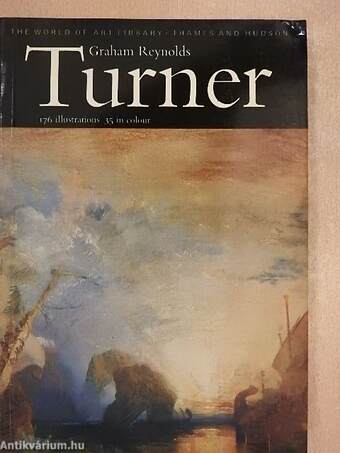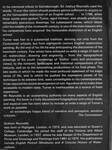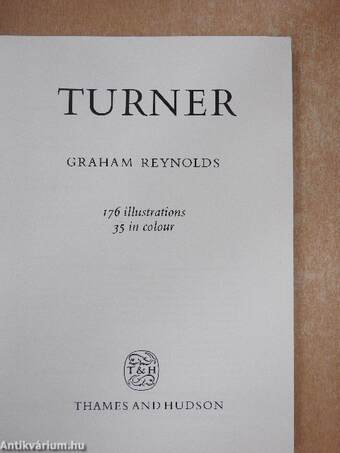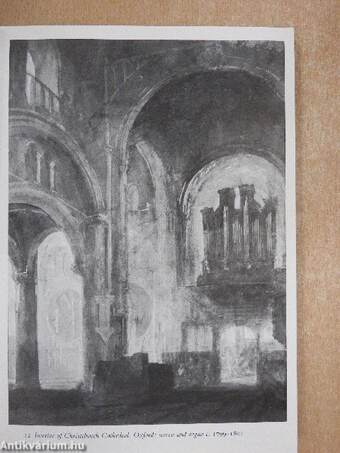1.067.339
kiadvánnyal nyújtjuk Magyarország legnagyobb antikvár könyv-kínálatát

VISSZA
A TETEJÉRE
JAVASLATOKÉszre-
vételek
Turner
| Kiadó: | Thames and Hudson Ltd. |
|---|---|
| Kiadás helye: | New York |
| Kiadás éve: | |
| Kötés típusa: | Ragasztott papírkötés |
| Oldalszám: | 216 oldal |
| Sorozatcím: | The World of Art Library |
| Kötetszám: | |
| Nyelv: | Angol |
| Méret: | 21 cm x 15 cm |
| ISBN: | 0-500-20083-1 |
| Megjegyzés: | Fekete-fehér és színes fotókkal, reprodukciókkal. |
naponta értesítjük a beérkező friss
kiadványokról
naponta értesítjük a beérkező friss
kiadványokról
Fülszöveg
In his memorial tribute to Gainsborough, Sir Joshua Reynolds used the words, 'lf ever this nation should produce genius sufficiënt to acquire to us the honourable distinction of an English school . . .' In 1788, when these words were spoken, Turner, aged thirteen, was already producing remarkably precocious drawings; his subsequent career, which lasted until the middle of the nineteenth Century, is one of the main reasons why his compatriots have acquired 'the honourable distinction of an English school.'
Turner was heir to a substantial tradition, deriving not only from the Continental schools, but from eighteenth-century English watercolour painting. By the end of his life he was anticipating the discoveries of the twentieth Century. Few artists have achieved so wide a range of style in oil, watercolour, drawing and engraving — from the topographical drawings of his youth (renderings of 'Gothic' ruins and picturesque views) to the romantic landscapes and historical compositions... Tovább
Fülszöveg
In his memorial tribute to Gainsborough, Sir Joshua Reynolds used the words, 'lf ever this nation should produce genius sufficiënt to acquire to us the honourable distinction of an English school . . .' In 1788, when these words were spoken, Turner, aged thirteen, was already producing remarkably precocious drawings; his subsequent career, which lasted until the middle of the nineteenth Century, is one of the main reasons why his compatriots have acquired 'the honourable distinction of an English school.'
Turner was heir to a substantial tradition, deriving not only from the Continental schools, but from eighteenth-century English watercolour painting. By the end of his life he was anticipating the discoveries of the twentieth Century. Few artists have achieved so wide a range of style in oil, watercolour, drawing and engraving — from the topographical drawings of his youth (renderings of 'Gothic' ruins and picturesque views) to the romantic landscapes and historical compositions of his maturity, and on to the astonishing productions of his final phase. The late works in which he made the most profound statement of his tragic sense of life, and in which he pushed the expressive power of his technique to its extreme limit, were unintelligible to his contemporaries. It has required the recent development of non-figurative art to make them accessible to modern taste. Turner is inexhaustible as a source of fresh experience.
Mr Reynolds is an outstanding authority on many aspects of English painting. His book is a fuliy documented biographical and criticaI study, and especial care has been taken to incJude as wide a range of Turner's work as possible.
'. . . an exceedingly happy blend of narrative and perceptive, sensitive criticism.' The Connoisseur.
Graham Reynolds
was bom irr Highgate, London, in 1914, and was educated at Queen's College, Cambridge. He joined the staff of the Victoria and Albert Museum, London, in 1937, where he was Keeper of the Department of Prints and Drawings and Paintings from 1961 to 1974. His publications include English Portrait Miniatures and A Concise History of Water -colours. Vissza
Témakörök
Graham Reynolds
Graham Reynolds műveinek az Antikvarium.hu-n kapható vagy előjegyezhető listáját itt tekintheti meg: Graham Reynolds könyvek, művekMegvásárolható példányok
Nincs megvásárolható példány
A könyv összes megrendelhető példánya elfogyott. Ha kívánja, előjegyezheti a könyvet, és amint a könyv egy újabb példánya elérhető lesz, értesítjük.









